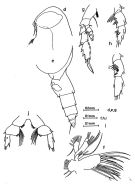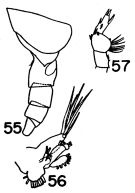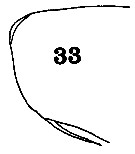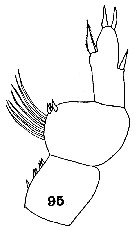|
|
 |
|
Calanoida ( Order ) |
|
|
|
Clausocalanoidea ( Superfamily ) |
|
|
|
Phaennidae ( Family ) |
|
|
|
Cephalophanes ( Genus ) |
|
|
| |
Cephalophanes tectus (Esterly, 1911) (F) | |
| | | | | | | Syn.: | Xanthocalanus tectus Esterly, 1911 (p.324, Descr.F, figs.F); Sewell, 1948 (p.557, 563); Brodsky, 1950 (1967) (p.232, figs.F) | | | | Ref.: | | | Grice, 1969 a (p.453, figs.F, Rem.); Tanaka & Omori, 1992 (p.254, figs.F, Rem.); Chihara & Murano, 1997 (p.852, Pl.139: F); Nishida & al., 2002 (p.158, tab.1, figs.F) |  issued from : O. Tanaka & M. Omori in Publs Seto Mar. Biol. Lab., 1992, 35 (4/5). [p.255, Fig.1, d-j]. Female: d, forehead (lateral); e, last thoracic segment and urosome (lateral left side); f, Mx1; g, P2; h, endopod of P3; i, endopod of P4; j, P5. Nota: Cephalosome and 1st metasomal segment separated, 4th and 5th separated. Prosome/urosome length ratio 81 : 19. Rostral filaments slender. A pair of large eyes. A1 extends beyond end of caudal ramus with 4 segments. Urosomal segments and caudal rami in the proportional lengths 42 : 21 : 16 : 4 : 17 = 100. Caudal rami with length/width ratio 2 : 3. A2 exopod a little longer than endopod (7 : 6). Mx2 endopod with 7 brushform and 1 vermiform sensory filaments.
|
 issued from : G.D. Grice in Bull. mar. Sc., 1969, 19 (2). [p.452, Figs.55-57]; Female (from G. of Mexico): 55, posterior end of cephalothorax and urosome (lateral right side); 56, Mx1; 57, P5. Nota: This specimen has a large lens on the forehead, apparently overlooked by Esterly.
|
 issued from : C.O. Esterly in Univ. Calif. Publs Zool., 1911, 6 (14). [Pl.28, Fig.33]. As Xanthocalanus tectus. Female (from San Diego Region): 33, forehead (lateral). Nota: Head with a very slight crest. A1 24-segmented and from one-fifth to one-sixth of their length longer than the body. Mx2 with 8 vermiform appendages. Cephalothorax 4-segmented, head and 1st thoracic segment fused
|
 issued from : C.O. Esterly in Univ. Calif. Publs Zool., 1911, 6 (14). [Pl.29, Fig.53]. As Xanthocalanus tectus. Female: 53, last thoracic segments and urosome (lateral), left side). Nota: abdomen 4-segmented. Genital segment as long as the 2nd and 3rd together and the anal is very short.
|
 issued from : C.O. Esterly in Univ. Calif. Publs Zool., 1911, 6 (14). [Pl.31, Fig.95]. As Xanthocalanus tectus. Female: 95, P5.
|
 issued from : O. Tanaka & M. Omori in Publs Seto Mar. Biol. Lab., 1992, 35 (4/5). [p. 256]. Female: Proportional lengths of segments of A1.
| | | | | Compl. Ref.: | | | Suarez-Morales & Gasca, 1998 a (p.110); Lapernat, 2000 (tabl.3, 4); in CalCOFI regional list (MDO, Nov. 2013; M. Ohman, comm. pers.) | | | | NZ: | 5 | | |
|
Distribution map of Cephalophanes tectus by geographical zones
|
| | |  Chart of 1996 Chart of 1996 | |
| | | | Loc: | | | NW Pacif., Japan (Izu region), W Pacif. (off Philippines, Indonesia, Australia), San Diego, G. of Mexico, off Mauritania - NW Cape Verde Is. (in Lapernat, 2000) | | | | N: | 6 | | | | Lg.: | | | (143) F: 4,25; (225) F: 4; (867) F: 4,1-4,23; (911) F: 3,15-4,5; {F: 3,15-4,50} | | | | Rem.: | Meso-bathypelagic.
After Campaner (1978 a, p.968) X. tectus Esterly, 1911, was removed by Grice (1969) to the genus Cephalophanes Sars, 1907, in which other species of Xanthocalanus are possibly congeneric, if the absence of luminous organs or eyes on the head is not taken into consideration.
Park (1983 a, p.321) doubts the identification of Grice (1969). However, it is not exceptional to observe a distribution like this corresponding to a period before the closure of the Isthmus of Panama.
After Tanaka & Omori (1992, p.256) Esterly (1911) in his description seems to overlooked a pair of large eyes in forehead.
The male, indicated by Chihara & Murano (1997) is no doubt a mistake. | | | Last update : 01/01/2015 | |
|
|
 Any use of this site for a publication will be mentioned with the following reference : Any use of this site for a publication will be mentioned with the following reference :
Razouls C., Desreumaux N., Kouwenberg J. and de Bovée F., 2005-2025. - Biodiversity of Marine Planktonic Copepods (morphology, geographical distribution and biological data). Sorbonne University, CNRS. Available at http://copepodes.obs-banyuls.fr/en [Accessed December 27, 2025] © copyright 2005-2025 Sorbonne University, CNRS
|
|
 |
 |







